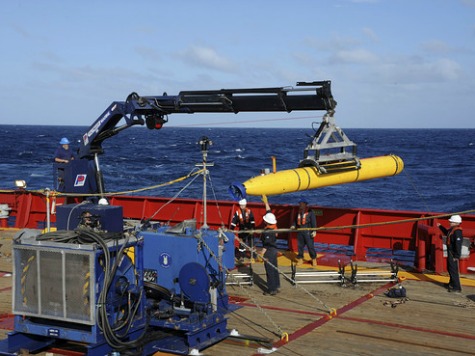A senior official on the Australian team searching for missing Malaysia Airlines Flight 370 believes most of the promising “pings” discovered in recent weeks may not be related to the missing plane’s black boxes. Australian naval Commander James Lybrand says half of the pings uncovered were likely not man-made.
Lybrand, who serves as the captain of the Ocean Shield vessel that has been in charge of the Australian wing of the search operation, tells The Wall Street Journal that two of the four radar pings picked up by Ocean Shield are unlikely to have come from a man-made object. The ship picked up four pings in April that investigators considered pivotal to the search. Of those, Lybrand says two were nowhere near the frequency at which black boxes transmit waves.
Investigators were searching for waves at a frequency of 37.5 kHz–a rare frequency in nature that black boxes are designed to emit, specifically because they are difficult to conflate with signals from other naturally occurring waves in the ocean. Two of the signals heard were only at a frequency of 27 kHz, lower than earlier transmissions and, by Lybrand’s estimate, “a pretty large jump” from where a man-made frequency would be.
Two of the signals, received on April 5, had a frequency of 33.3 kHz–still lower than what black boxes are designed to emit, but not so much so that the change could not be attributable to diminished battery life on the black boxes. As a black box’s battery is designed to last only about a month, search groups have mostly given up hope of picking up this frequency. They are, instead, relying on an underwater drone to scan the search area for wreckage.
The Daily Mail notes that Lybrand did not tell the The Wall Street Journal what could have made the signals, if they were not man-made, but poses the possibility that marine mammals could have made them. The paper notes that dolphins have an extremely wide range of sonar frequencies they use to communicate–between 0.2 kHz and 150kHz–and could have been responsible for the signals the Ocean Shield received.
Last week, University of Hong Kong archaeologist William Meacham wrote in the The Malaysia Insider that he also believed marine animals could have created the signals picked up by investigation teams–either naturally or by virtue of being tracked by researchers, who often tag marine animals to study their natural trajectories and then let them go into the wild.
The disappointing news that information previously believed to be promising has yielded few, if any, new results follows the news that Australia is committed to spending an astronomical amount of money to find the plane. A report in the New Straits Times finds that the nation has budgeted 90 million Australian dollars–about $84 million–to spend on the search operation during the current fiscal year. Australia is leading the search, but it has the aid of other countries such as China and the United States, which provided the underwater drone Bluefin-21, used to search the ocean floor.

COMMENTS
Please let us know if you're having issues with commenting.